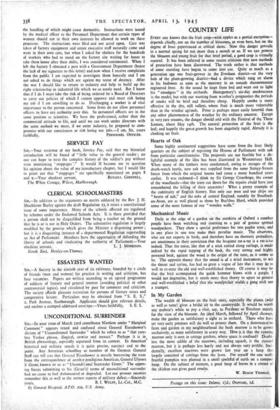COUNTRY LIFE
EVERY one knows that the fruit crop—with apples as a partial exception— depends chiefly, not on the number of blossoms, or even bees, but on the degree of frost experienced at critical dates. Now this danger prevails in a normal spring for not more than a month or so. If we can protect the blossom and young fruit for that brief period, a good crop is virtually assured. It has been inferred in some recent criticism that new methods of protection have been discovered. The truth rather is that methods of some standing have begun to come into use. Quite as much as a generation ago one fruit-grower in the Evesham district—at the very hub of the plum-growing district—had a device which rang an alarm in his bedroom as soon as the mercury in an outside thermomenter registered frost. At the sound he leapt from bed and went out to light his " smudgers " in the orchards. Montgomery's six-day smokescreen is the model, but with our warning from weather's prognostics the periods of smoke will be brief and therefore cheap. Happily smoke is more effective in the dry, still valleys, where fruit is much more vulnerable than in the windier uplands. Frost is perhaps more easily foretold than any other phenomenon of the weather by the ordinary amateur. Except in very rare seasons, the danger should end with the Festival of the Three Icemen, about May 14th. The natural protection of the fruit is the leaf; and happily the green growth has been singularly rapid. Already it is cloaking set fruit.
Hearts of Oak
Some highly sentimental suggestions have come from the least likely quarters on the subject of repairing the Houses of Parliament with oak from particular constituencies. The proposals are not feasible but a de- lightful example of the idea has been illustrated in Westminster Hall. When many of the timbers were condemned, owing to ravages of the death-watch beetle, new oak was supplied from the same Surrey-Sussex forest from which the original beams had come a many hundred years earlier. It was reckoned—I think by Sir George Courthope, the owner of the woodlands—that the trees cut down for the repairs could have just remembered the felling of their ancestors! What a pretty example of the continuity of English history. Not only our men and our ships are " hearts of oak," and the oaks of central England, notably by Stratford- on-Avon, are as well placed as those by Bucklers Hard, which provided some of the most famous of our " wooden walls."
Mechanical Music
Daily at the edge of a garden on the outskirts of Oxford a number people have been watching and listening to a pair of greater spotted woodpeckers. They show a special preference for two poplar trees, and in one place in one tree make their peculiar music. The observers, who are not experts in birds, and therefore have no theoretic prejudices, are unanimous in their conviction that the frequent rat-a-tat is a rat-a-tat indeed. That the noise, like that of a stick rattled along railings, is made indeed by the rapid tapping of the beak, the very strong and highly powered beak, against the wood is the origin of the tune, Eta it seems to be. The opposite theory that the sound is of a wind instrument, to wit the throat and syrinx, has had so great a vogue of late that it may be as well to re-state the old and well-established theory. Of course it may be that the bird accompanied the quick hammer blows with a gurgle. I would not dogmatize, but it needs more than theory to upset so general and well-established a belief that the woodpecker wields",a gong stick not a trumpet.
In My Garden The wealth of blossom on the fruit trees, especially the plums (wild as well as tame) gives a bridal air to the countryside. It would be worth any xsthete's while to pay a visit, say, to Pershore or Evesham merely for the view of the blossom. An ideal March, followed by. April showers, make the garden as satisfactory a sight as in orchard. Those who have set very early potatoes will do well to protect them. On a demonstration farm and garden in my neighbourhood the bush marrow is to be grown exclusively, as more satisfactory in every way. How is it that the running marrow only is seen in cottage gardens, where space is confined? Doubt- less the most edible of the marrows, including squash, is the custard marrow, but it is perhaps less hardy and not always very prolific. Inci- dentally, excellent marrows were grown last year on a heap that largely consisted of cuttings from the lawn. For myself the one real!, fruitful pumpkin was planted in a small spadeful of earth on a compos: heap. On the subject of manure, a good heap of leaves in a corner- the chicken run gives good results. W. BEACH THOMAS.
• Postage on this issue: Inland, Ild.; Overseas, ad.


























 Previous page
Previous page